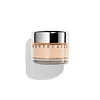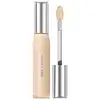Chantecaille Future Skin Gel Foundation Versus Haus Labs By Lady Gaga Triclone Skin Tech Hydrating Concealer with Fermented Arnica
What's inside
What's inside
 Key Ingredients
Key Ingredients

 Benefits
Benefits

 Concerns
Concerns

 Ingredients Side-by-side
Ingredients Side-by-side

Water
Skin ConditioningCyclopentasiloxane
EmollientTitanium Dioxide
Cosmetic ColorantCetyl PEG/PPG-10/1 Dimethicone
EmulsifyingPentylene Glycol
Skin ConditioningDimethicone
EmollientButylene Glycol
HumectantTalc
AbrasivePEG-400
Emulsion StabilisingSodium Chloride
MaskingSilica Dimethyl Silylate
EmollientPhenoxyethanol
PreservativeGlycerin
HumectantAluminum Hydroxide
EmollientMica
Cosmetic ColorantDimethicone/Vinyl Dimethicone Crosspolymer
Skin ConditioningChlorphenesin
AntimicrobialStearic Acid
CleansingAlcohol
AntimicrobialLaminaria Saccharina Extract
Skin ProtectingCamellia Sinensis Leaf Extract
AntimicrobialRosmarinus Officinalis Leaf Extract
AntimicrobialOryza Sativa Bran Extract
Skin ConditioningArnica Montana Flower Extract
MaskingChamomilla Recutita Flower Extract
MaskingAloe Barbadensis Leaf Extract
EmollientNatto Gum
Iron Oxides
Water, Cyclopentasiloxane, Titanium Dioxide, Cetyl PEG/PPG-10/1 Dimethicone, Pentylene Glycol, Dimethicone, Butylene Glycol, Talc, PEG-400, Sodium Chloride, Silica Dimethyl Silylate, Phenoxyethanol, Glycerin, Aluminum Hydroxide, Mica, Dimethicone/Vinyl Dimethicone Crosspolymer, Chlorphenesin, Stearic Acid, Alcohol, Laminaria Saccharina Extract, Camellia Sinensis Leaf Extract, Rosmarinus Officinalis Leaf Extract, Oryza Sativa Bran Extract, Arnica Montana Flower Extract, Chamomilla Recutita Flower Extract, Aloe Barbadensis Leaf Extract, Natto Gum, Iron Oxides
Water
Skin ConditioningGlycerin
HumectantDiphenylsiloxy Phenyl Trimethicone
Skin ConditioningTrimethylsiloxysilicate
EmollientCaprylyl Methicone
Skin ConditioningLauryl Polyglyceryl-3 Polydimethylsiloxyethyl Dimethicone
Skin ConditioningC13-15 Alkane
SolventIsododecane
EmollientDimethicone
EmollientMethyl Trimethicone
Skin ConditioningPolypropylsilsesquioxane
Phenyl Trimethicone
Skin ConditioningDisteardimonium Hectorite
StabilisingPolymethylsilsesquioxane
Magnesium Sulfate
Acrylates/Dimethicone Copolymer
Skin ConditioningArnica Montana Flower Extract
MaskingNiacinamide
SmoothingSqualane
EmollientHydrolyzed Hyaluronic Acid
HumectantColeus Forskohlii Root Extract
EmollientSodium Hyaluronate
HumectantHyaluronic Acid
HumectantPseudozyma Epicola/Camellia Sinensis Seed Oil Ferment Extract Filtrate
HumectantPrunus Armeniaca Kernel Oil
MaskingPseudozyma Epicola/Apricot Kernel Oil/Olive Fruit Oil/Sunflower Seed Oil/Sweet Almond Oil/(Angelica Gigas/Lithospermum Erythrorhizon) Root Extract Ferment Extract Filtrate
Solanum Lycopersicum Fruit Extract
AntioxidantDunaliella Salina Extract
Skin ConditioningSodium Acetylated Hyaluronate
HumectantSodium Hyaluronate Crosspolymer
HumectantPseudanabaena Galeata Extract
Skin ConditioningHydrolyzed Sodium Hyaluronate
Skin ConditioningTocopherol
AntioxidantPotassium Hyaluronate
Skin ConditioningPseudozyma Epicola/Sunflower Seed Oil Ferment Extract Filtrate
Emulsion StabilisingBetaine
HumectantHydroxypropyltrimonium Hyaluronate
Caprylyl Glycol
EmollientAloe Barbadensis Leaf Extract
EmollientSorbitan Sesquioleate
EmulsifyingPolyglyceryl-3 Polydimethylsiloxyethyl Dimethicone
Skin ConditioningAcrylates/Polytrimethylsiloxymethacrylate Copolymer
Skin Conditioning1,2-Hexanediol
Skin ConditioningEthylhexylglycerin
Skin ConditioningDimethicone/Vinyl Dimethicone Crosspolymer
Skin ConditioningCetearyl Dimethicone/Vinyl Dimethicone Crosspolymer
EmollientTriethoxycaprylylsilane
Xanthan Gum
EmulsifyingSilica Silylate
EmollientAluminum Hydroxide
EmollientBoron Nitride
AbsorbentCI 77491
Cosmetic ColorantCI 77891
Cosmetic ColorantWater, Glycerin, Diphenylsiloxy Phenyl Trimethicone, Trimethylsiloxysilicate, Caprylyl Methicone, Lauryl Polyglyceryl-3 Polydimethylsiloxyethyl Dimethicone, C13-15 Alkane, Isododecane, Dimethicone, Methyl Trimethicone, Polypropylsilsesquioxane, Phenyl Trimethicone, Disteardimonium Hectorite, Polymethylsilsesquioxane, Magnesium Sulfate, Acrylates/Dimethicone Copolymer, Arnica Montana Flower Extract, Niacinamide, Squalane, Hydrolyzed Hyaluronic Acid, Coleus Forskohlii Root Extract, Sodium Hyaluronate, Hyaluronic Acid, Pseudozyma Epicola/Camellia Sinensis Seed Oil Ferment Extract Filtrate, Prunus Armeniaca Kernel Oil, Pseudozyma Epicola/Apricot Kernel Oil/Olive Fruit Oil/Sunflower Seed Oil/Sweet Almond Oil/(Angelica Gigas/Lithospermum Erythrorhizon) Root Extract Ferment Extract Filtrate, Solanum Lycopersicum Fruit Extract, Dunaliella Salina Extract, Sodium Acetylated Hyaluronate, Sodium Hyaluronate Crosspolymer, Pseudanabaena Galeata Extract, Hydrolyzed Sodium Hyaluronate, Tocopherol, Potassium Hyaluronate, Pseudozyma Epicola/Sunflower Seed Oil Ferment Extract Filtrate, Betaine, Hydroxypropyltrimonium Hyaluronate, Caprylyl Glycol, Aloe Barbadensis Leaf Extract, Sorbitan Sesquioleate, Polyglyceryl-3 Polydimethylsiloxyethyl Dimethicone, Acrylates/Polytrimethylsiloxymethacrylate Copolymer, 1,2-Hexanediol, Ethylhexylglycerin, Dimethicone/Vinyl Dimethicone Crosspolymer, Cetearyl Dimethicone/Vinyl Dimethicone Crosspolymer, Triethoxycaprylylsilane, Xanthan Gum, Silica Silylate, Aluminum Hydroxide, Boron Nitride, CI 77491, CI 77891
 Reviews
Reviews

Ingredients Explained
These ingredients are found in both products.
Ingredients higher up in an ingredient list are typically present in a larger amount.
Aloe Barbadensis Leaf Extract is an extract of the leaves of the aloe, Aloe barbadensis, Liliaceae.
Aloe is one of the most well-known natural soothing ingredients, and for good reason. It’s full of water and has a cooling, calming effect on the skin, especially when it’s sunburned, itchy, or irritated. Aloe also helps your skin stay hydrated and smooth by mimicking what healthy skin naturally produces. On top of that, it contains vitamins and nutrients that support skin recovery.
It doesn’t protect you from the sun, but it can help your skin bounce back after too much time in it.
Let’s get into the details:
Aloe contains antioxidant Vitamins A, C, and E, which help fight off free radicals (unstable molecules from things like pollution that can damage your skin).
It’s also rich in polysaccharides, which are natural sugars that help hydrate the skin by acting like the skin’s own moisturizing agents. These, along with other sugars like monosaccharides, help form a protective barrier that locks in moisture.
Aloe works as both a humectant and an emollient. That means it draws water into the skin (humectant) and helps trap it there (emollient), making it an effective natural moisturizer.
You’ll also find a mix of other skin-supporting ingredients in aloe, including folic acid, choline, calcium, amino acids, fatty acids, and even Vitamin B12.
Out of the 420+ species of aloe, Aloe barbadensis is the most widely used in skincare products thanks to its gentle yet effective properties.
There are over 420 species of aloe but Aloe Barbadensis is the most commonly used for topical products.
Learn more about Aloe Barbadensis Leaf ExtractAluminum Hydroxide is a form of aluminum. It can be naturally found in nature as the mineral gibbsite. In cosmetics, Aluminum Hydroxide is used as a colorant, pH adjuster, and absorbent.
As a colorant, Aluminum Hydroxide may add opacity, or reduce the transparency. Aluminum hydroxide is contains both basic and acidic properties.
According to manufacturers, this ingredient is an emollient and humectant. This means it helps hydrate the skin.
In medicine, this ingredient is used to help relieve heartburn and help heal ulcers.
There is currently no credible scientific evidence linking aluminum hydroxide in cosmetics to increased cancer risk.
Major health organizations allow the use of aluminum hydroxide in personal care products and have not flagged it as a carcinogenic risk at typical usage levels.
Learn more about Aluminum HydroxideArnica Montana Flower is more commonly known as Wolf's Bane. While this flower has been used in traditional medicine, its skin benefits are in question.
The FDA considers Wolf's Bane to be an unsafe herb. They advise against taking it orally or applying it to broken skin.
Wolf's Bane has been said to have anti-inflammatory properties. However, studies are conflicting about whether this is true.
According to the Final report on the safety assessment of Arnica montana, this plant has not been found to cause dermal irritation.
This flower contains numerous fatty acids such as palmitic, linoleic, myristic, and linolenic acids. The presence and amount of fatty acids depends on where the flower is harvested.
Like other flowers, this ingredient has a natural fragrance. It can also be used to mask, or cover, the unpleasant scents from other ingredients.
Learn more about Arnica Montana Flower ExtractDimethicone is a type of synthetic silicone created from natural materials such as quartz.
What it does:
Dimethicone comes in different viscosities:
Depending on the viscosity, dimethicone has different properties.
Ingredients lists don't always show which type is used, so we recommend reaching out to the brand if you have questions about the viscosity.
This ingredient is unlikely to cause irritation because it does not get absorbed into skin. However, people with silicone allergies should be careful about using this ingredient.
Note: Dimethicone may contribute to pilling. This is because it is not oil or water soluble, so pilling may occur when layered with products. When mixed with heavy oils in a formula, the outcome is also quite greasy.
Learn more about DimethiconeThis ingredient is a silicone used to improve the texture of products and absorb oil. It does not get absorbed into the skin.
Like other silicones, Dimethicone/Vinyl Dimethicone Crosspolymer helps condition the skin by creating a barrier. In this sense, it can act as an emollient and trap moisture in.
This ingredient is a type of elastomer.
Learn more about Dimethicone/Vinyl Dimethicone CrosspolymerGlycerin is already naturally found in your skin. It helps moisturize and protect your skin.
A study from 2016 found glycerin to be more effective as a humectant than AHAs and hyaluronic acid.
As a humectant, it helps the skin stay hydrated by pulling moisture to your skin. The low molecular weight of glycerin allows it to pull moisture into the deeper layers of your skin.
Hydrated skin improves your skin barrier; Your skin barrier helps protect against irritants and bacteria.
Glycerin has also been found to have antimicrobial and antiviral properties. Due to these properties, glycerin is often used in wound and burn treatments.
In cosmetics, glycerin is usually derived from plants such as soybean or palm. However, it can also be sourced from animals, such as tallow or animal fat.
This ingredient is organic, colorless, odorless, and non-toxic.
Glycerin is the name for this ingredient in American English. British English uses Glycerol/Glycerine.
Learn more about GlycerinWater. It's the most common cosmetic ingredient of all. You'll usually see it at the top of ingredient lists, meaning that it makes up the largest part of the product.
So why is it so popular? Water most often acts as a solvent - this means that it helps dissolve other ingredients into the formulation.
You'll also recognize water as that liquid we all need to stay alive. If you see this, drink a glass of water. Stay hydrated!
Learn more about Water